U.S. Unemployment Soars to 26 Year High
Economics / Recession 2008 - 2010 Oct 02, 2009 - 11:43 AM GMTBy: Mike_Shedlock
 Sorry folks, I was one month early. In January I forecast the unemployment rate would hit 9.8% by August. Meanwhile, even though it was clear the Fed was wildly off base in its adverse scenario, the Fed upped it total to a mere 9.2% to 9.6% for the year as noted on May 21, 2009 in Fed's Economic Forecast Worsens; Still Ridiculously Optimistic.
Sorry folks, I was one month early. In January I forecast the unemployment rate would hit 9.8% by August. Meanwhile, even though it was clear the Fed was wildly off base in its adverse scenario, the Fed upped it total to a mere 9.2% to 9.6% for the year as noted on May 21, 2009 in Fed's Economic Forecast Worsens; Still Ridiculously Optimistic.
The Fed's forecasts, released as part of the minutes from its April meeting, show that its staff now expects the unemployment rate to rise to between 9.2% and 9.6% this year. The central bank had forecast in January that the jobless rate would be in a range of 8.5% to 8.8%, but the unemployment rate topped that in April, hitting 8.9%.
Even the Fed's revised forecast has now proven to be optimistic although there are still three months to go.
As I said prior to the jobs announcement, Collectively, Economists Are A Perpetually Optimistic Lot. Cynics might think purposely so, hoping to buy time.
This morning, the Bureau of Labor Statistics (BLS) released the September Employment Report.
Nonfarm payroll employment continued to decline in September (-263,000), and the unemployment rate (9.8 percent) continued to trend up, the U.S. Bureau of Labor Statistics reported today. The largest job losses were in construction, manufacturing, retail trade, and government..
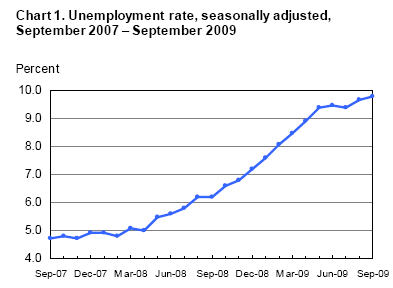
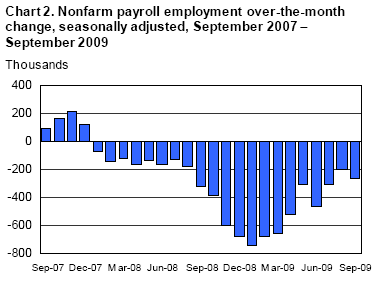
Establishment Data

Highlights
- 263,000 jobs were lost in total vs. 216,000 jobs last month.
- 64,000 construction jobs were lost vs. 65,000 last month.
- 51,000 manufacturing jobs were lost vs. 63,000 last month.
- 147,000 service providing jobs were lost vs. 80,000 last month.
- 39,000 retail trade jobs were lost vs. 10,000 last month.
- 8,000 professional and business services jobs were lost vs. 22,000 last month.
- 3,000 education and health services jobs were added vs. 52,000 added last month.
- 9,000 leisure and hospitality jobs were lost vs. 21,000 added last month.
- 53,000 government jobs were lost vs. 18,000 last month.
The one cheery bit of news in the above numbers is the loss of 53,000 government jobs. Unfortunately, this trend is likely to reverse in a major way with as of yet unannounced son-of-stimulus and grandson-of-stimulus jobs packages.
Note: some of the above categories overlap as shown in the preceding chart, so do not attempt to total them up.
Index of Aggregate Weekly Hours
Work hours dropped .1 to 33.0. Short work weeks contribute to household problems. Moreover, before hiring begins at many places, work weeks will increase.
Birth Death Model Revisions 2008
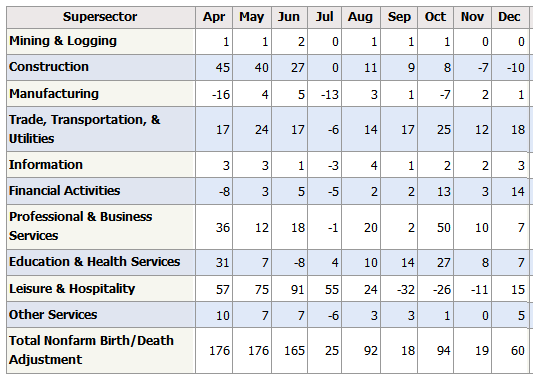
Not sure what happened to the format of the following table but here are this months birth/death revisions.
Birth Death Model Revisions 2009
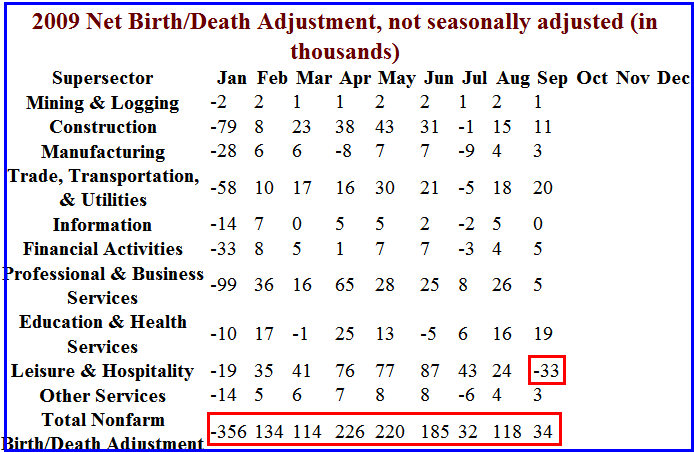
Birth/Death Model Revisions
After the typical in January in which the Birth/Death Model revisions bore some semblance of reality, the Birth/Death numbers remain in deep outer space.
At this point in the cycle birth death numbers should have been massively contracting for months. The BLS is going to keep adding jobs through the entire recession in a complete display of incompetence.
However, what does stand out this month is the loss of 33,000 Leisure and Hospitality Jobs.
Leisure and Hospitality Categories
- Arts, entertainment, and recreation
- Food services and drinking places
- Hotels and other accommodations
Please note that one cannot subtract or add birth death revisions to the reported totals and get a meaningful answer. One set of numbers is seasonally adjusted the other is not. In the black box the BLS combines the two coming out with a total. The Birth Death numbers influence the overall totals but the math is not as simple as it appears and the effect is nowhere near as big as it might logically appear at first glance.
BLS Black Box
For those unfamiliar with the birth/death model, monthly jobs adjustments are made by the BLS based on economic assumptions about the birth and death of businesses (not individuals). Those assumptions are made according to estimates of where the BLS thinks we are in the economic cycle.
The BLS has admitted however, that their model will be wrong at economic turning points. And there is no doubt we are long past an economic turning point.
Here is the pertinent snip from the BLS on Birth/Death Methodology.
- The net birth/death model component figures are unique to each month and exhibit a seasonal pattern that can result in negative adjustments in some months. These models do not attempt to correct for any other potential error sources in the CES estimates such as sampling error or design limitations.
- Note that the net birth/death figures are not seasonally adjusted, and are applied to not seasonally adjusted monthly employment links to determine the final estimate.
- The most significant potential drawback to this or any model-based approach is that time series modeling assumes a predictable continuation of historical patterns and relationships and therefore is likely to have some difficulty producing reliable estimates at economic turning points or during periods when there are sudden changes in trend.
Household Data
Since the start of the recession in December 2007, the number of unemployed persons has increased by 7.6 million to 15.1 million, and the unemployment rate has doubled to 9.8 percent.
The civilian labor force participation rate declined by 0.3 percentage point in September to 65.2 percent. The employment-population ratio, at 58.8 percent, also declined over the month and has decreased by 3.9 percentage points since the recession began in December 2007.
In September, the number of persons working part time for economic reasons (sometimes referred to as involuntary part-time workers) was little changed at 9.2 million. The number of such workers rose sharply throughout most of the fall and winter but has been little changed since March.
Persons Not in the Labor Force
About 2.2 million persons were marginally attached to the labor force in September, an increase of 615,000 from a year earlier. (The data are not seasonally adjusted.) These individuals were not in the labor force, wanted and were available for work, and had looked for a job sometime in the prior 12 months. They were not counted as unemployed because they had not searched for work in the 4 weeks preceding the survey.
Among the marginally attached, there were 706,000 discouraged workers in September, up by 239,000 from a year earlier. (The data are not seasonally adjusted.) Discouraged workers are persons not currently looking for work because they believe no jobs are available for them. The other 1.5 million persons marginally attached to the labor force in September had not searched for work in the 4 weeks preceding the survey for reasons such as school attendance or family responsibilities.
Some "Recovery"
In a typical recovery, the participation rate should go up not down. The reason is people hear there is a recovery, hear things are getting better, hear the talk about "green shoots" and think there might be a job if they go looking.
Instead we see the participation rate drop by .3 and the civilian labor force drop by 571,00 workers. In normal condition, the civilian labor force ought to be growing by 120,000 a month due to increasing population and immigration.
Is this a "recovery"?
Table A-5 Part Time Status

The chart shows there are 9.18 million people are working part time but want a full time job. A year ago the number was 6.3 million. This series has stabilized for the last 6 months.
The key take-away from this series are the millions of workers whose hours will rise before companies start hiring more workers.
Table A-12
Table A-12 is where one can find a better approximation of what the unemployment rate really is. Let's take a look
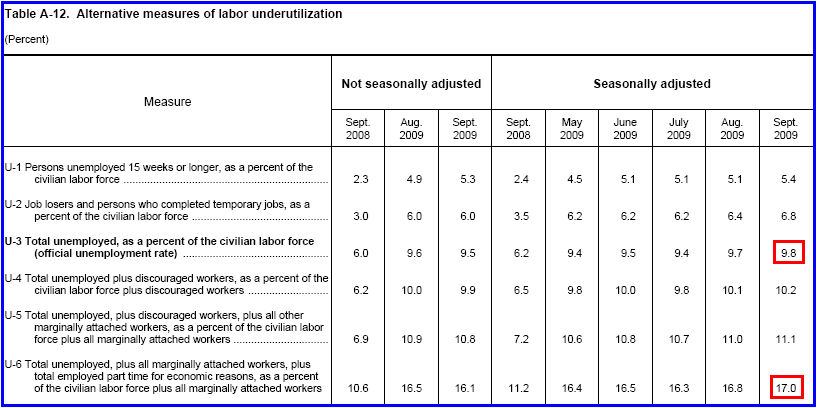
Grim Statistics
The official unemployment rate is 9.8% and rising. However, if you start counting all the people that want a job but gave up, all the people with part-time jobs that want a full-time job, all the people who dropped off the unemployment rolls because their unemployment benefits ran out, etc., you get a closer picture of what the unemployment rate is. That number is in the last row labeled U-6.
It reflects how unemployment feels to the average Joe on the street. U-6 is 17.0%. Both U-6 and U-3 (the so called "official" unemployment number) are poised to rise further although most likely at a slower pace than earlier this year.
Looking ahead, there is no driver for jobs and states in forced cutback mode are making matters far worse.
Unemployment is likely to continue rising until sometime in 2011.
Depression Level Statistics
I consider these job losses to be depression level totals. Admittedly conditions are not as bad as the great depression, but this is certainly no ordinary recession by any economic measure including lending, housing, bank failures, jobs, the stock market, commodity prices, treasury yields etc. For more on this idea please see Humpty Dumpty On Inflation.
By Mike "Mish" Shedlock
http://globaleconomicanalysis.blogspot.com
Click Here To Scroll Thru My Recent Post List
Mike Shedlock / Mish is a registered investment advisor representative for SitkaPacific Capital Management . Sitka Pacific is an asset management firm whose goal is strong performance and low volatility, regardless of market direction.
Visit Sitka Pacific's Account Management Page to learn more about wealth management and capital preservation strategies of Sitka Pacific.
I do weekly podcasts every Thursday on HoweStreet and a brief 7 minute segment on Saturday on CKNW AM 980 in Vancouver.
When not writing about stocks or the economy I spends a great deal of time on photography and in the garden. I have over 80 magazine and book cover credits. Some of my Wisconsin and gardening images can be seen at MichaelShedlock.com .
© 2009 Mike Shedlock, All Rights Reserved
Mike Shedlock Archive |
© 2005-2022 http://www.MarketOracle.co.uk - The Market Oracle is a FREE Daily Financial Markets Analysis & Forecasting online publication.



